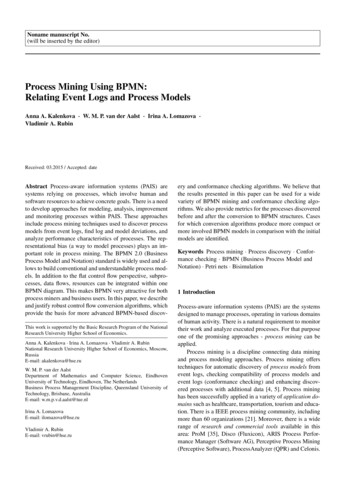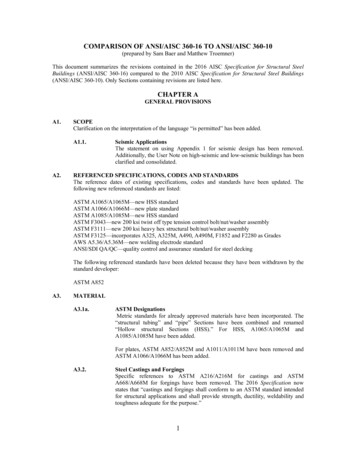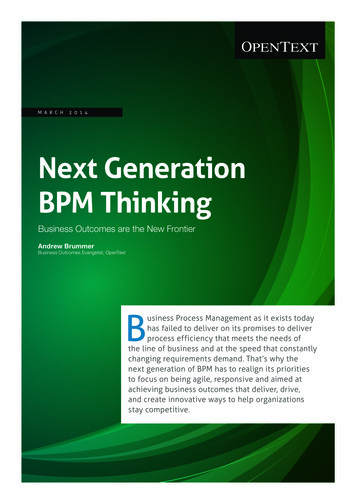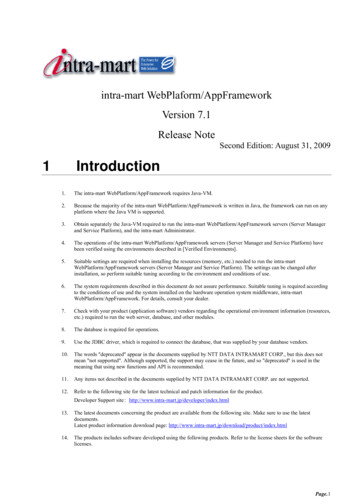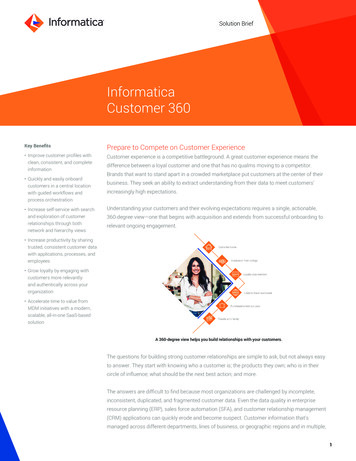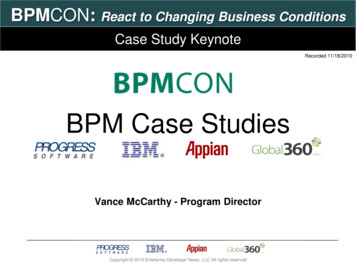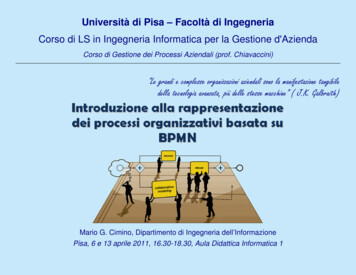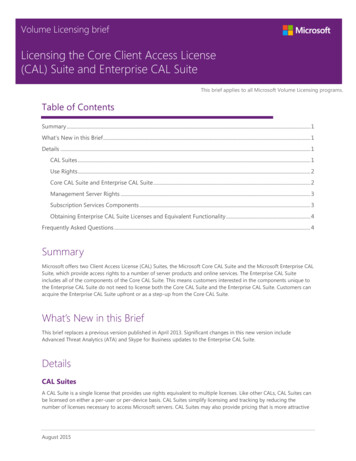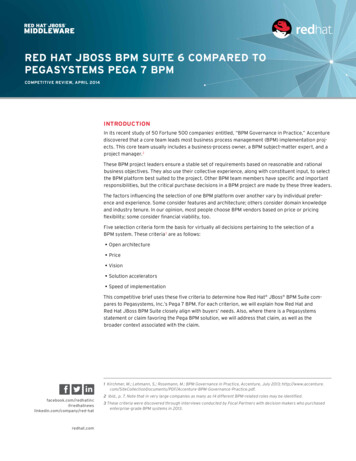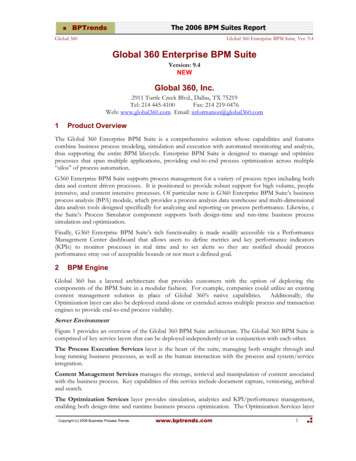
Transcription
Global 360Global 360 Enterprise BPM Suite, Ver. 9.4Global 360 Enterprise BPM SuiteVersion: 9.4NEWGlobal 360, Inc.2911 Turtle Creek Blvd., Dallas, TX 75219Tel: 214 445-4100Fax: 214 219-0476Web: www.global360.com Email: information@global360.com1Product OverviewThe Global 360 Enterprise BPM Suite is a comprehensive solution whose capabilities and featurescombine business process modeling, simulation and execution with automated monitoring and analysis,thus supporting the entire BPM lifecycle. Enterprise BPM Suite is designed to manage and optimizeprocesses that span multiple applications, providing end-to-end process optimization across multiple“silos” of process automation.G360 Enterprise BPM Suite supports process management for a variety of process types including bothdata and content driven processes. It is positioned to provide robust support for high volume, peopleintensive, and content intensive processes. Of particular note is G360 Enterprise BPM Suite’s businessprocess analysis (BPA) module, which provides a process analysis data warehouse and multi-dimensionaldata analysis tools designed specifically for analyzing and reporting on process performance. Likewise, cthe Suite’s Process Simulator component supports both design-time and run-time business processsimulation and optimization.Finally, G360 Enterprise BPM Suite’s rich functionality is made readily accessible via a PerformanceManagement Center dashboard that allows users to define metrics and key performance indicators(KPIs) to monitor processes in real time and to set alerts so they are notified should processperformance stray out of acceptable bounds or not meet a defined goal.2BPM EngineGlobal 360 has a layered architecture that provides customers with the option of deploying thecomponents of the BPM Suite in a modular fashion. For example, companies could utilize an existingcontent management solution in place of Global 360’s native capabilities. Additionally, theOptimization layer can also be deployed stand-alone or extended across multiple process and transactionengines to provide end-to-end process visibility.Server EnvironmentFigure 1 provides an overview of the Global 360 BPM Suite architecture. The Global 360 BPM Suite iscomprised of key service layers that can be deployed independently or in conjunction with each other.The Process Execution Services layer is the heart of the suite, managing both straight through andlong running business processes, as well as the human interaction with the process and system/serviceintegration.Content Management Services manages the storage, retrieval and manipulation of content associatedwith the business process. Key capabilities of this service include document capture, versioning, archivaland search.The Optimization Services layer provides simulation, analytics and KPI/performance management,enabling both design-time and runtime business process optimization. The Optimization Services layer1
Global 360Global 360 Enterprise BPM Suite, Ver. 9.4is capable of optimizing processes that span multiple process execution systems, including BPM systemsother than Global 360, thus providing an overall view of process performance. The OptimizationServices layer is also available on a stand-alone basis (i.e., separate offering) as the Business OptimizationServer (BOS) product.Client ElementsGlobal 360 BPM Suite supports a variety of client interfaces including Microsoft Office, SharePoint andnative web applications. In addition, the Suite provides a rapid application building environment whichanalysts can use to assemble rich process applications with zero coding. Forms-based interactionsupport is provided via integration with Microsoft InfoPath.Modeling &&ModelingSimulationSimulationDashboards ationsApplicationsBusiness Process Management SuiteOptimization ServicesServices (BOS)(BOS)OptimizationProcess ExecutionExecution ServicesServicesProcessContent ManagementManagement ServicesServicesContentInfrastructure tionIntegrationOtherSAPSecurity /AuthenticationORCLOtherTransactionsFigure 1. Overview of the Global 360 Enterprise BPM architecture.Web ServicesThe Global 360 BPM Suite has a rich SOA infrastructure, enabling both Web Services consumption andprovisioning. Web Services integration can be modeled and tested as a process activity with zerocoding. Processes can be enabled as Web Services and are published to either an external or a built-inservices repository. Services orchestration is enabled through a combination of these capabilities.2
Global 360Global 360 Enterprise BPM Suite, Ver. 9.4Figure 2. Web Services definition and setup in Global 360 BPM Suite.2.1PlatformsThe Global 360 BPM Suite is based on the Microsoft .NET platform and requires deployment onWindows servers. A relational database is also required, such as Microsoft SQL Server or Oracle. Inaddition, the Business Process Analysis (BPA) module requires the use of SQL Server’s AnalysisServices. The runtime services of the Global 360 BPM Suite are based on the Microsoft .NET platform.From an end-user application perspective, applications can be deployed using a variety of applicationserver platforms, including J2EE, JSP, ASP, ASP.NET and others. Additionally, leveraging the SOAbased platform API infrastructure, BPM Suite supports interaction and integration with virtually anyservice enabled platform, ranging from Java to Legacy to Microsoft.2.2User InterfaceA variety of end-user interfaces are supported natively within the product, including MicrosoftInfoPath, SharePoint, Office, custom applications (both thick and thin client) and applications builtusing Global 360’s Application Designer. Application Designer allows a business analyst to rapidlyassemble end-user applications using over 20 pre-built web application components provided by Global360. Partners and customers can also extend this library to support other advanced customizations.Figure 3. End-user interface in Global 360 BPM Suite.2.3Scalability3
Global 360Global 360 Enterprise BPM Suite, Ver. 9.4Horizontal and vertical scalability are inherent to the architecture of the Global 360 BPM Suite. Boththe Process Execution and Content Management Services employ an agent-based model that canleverage the processing power of any number of CPUs on a physical machine. Additionally, horizontalscalability is supported through clustering and failover technologies such as Microsoft ClusteringServices. The Business Optimization Services layer is a fully managed .NET application that leveragesthe inherent capabilities of the application server for both horizontal and vertical scalability.3Processing ModelingGlobal 360 features an integrated, multi-tiered modeling environment that allows the business andprocess analyst to focus on the actual business process, while enabling systems analysts to develop thesupporting implementation based on the business process. Additionally, web based renditions of thebusiness process are available for business process owners to make adaptations to changing businessconditions. These adaptations include changes to KPI goals, decision-making and work routing rulesand other parameters. This architecture enables rapid change and adaptation without compromisingcore system and process integrity. The process model and associated rules are stored in a commonmanaged repository, obviating the need for model synchronization as changes are made.Process modeling and definition is facilitated with the Process Modeler. There are two editions of thistool:Designer Edition with SimulationThis is the Global 360 tool for drawing high-level business process models based on the standardBusiness Process Management Notation (BPMN). Designed for the business analyst, the ProcessModeler provides a simple means of communicating process information to other business users,process implementers, customers, and suppliers.The integrated Process Simulator is designed by business processing experts and uniquely created forbusiness process simulation. Multiple scenarios can be simulated and results can be analyzed in an online process statistics view panel and optionally published to CSV, XML and HTML files. This robustforecasting tool is used for exploring “what-if” business scenarios. For example, a business may want todetermine the effect that a region outage due to a weather situation will have on their ability to meettheir service-level agreements. The simulated scenario data can be seamlessly sent to the Global 360Analysis Engine for reporting and analysis.Builder EditionThis version features an intuitive graphical modeling interface that allows business analysts and businessprocess owners to easily define business processes by dragging and dropping worksteps into a processmap. No programming is necessary. In addition to defining business processes, it is possible toconfigure rules governing how those processes will execute, specify resources to perform steps withinthe process, and indicate business goals for which the process must optimize.3.1SubprocessesProcess sub-setting is fully supported in the Global 360 modeling environment. Sub processes, orprocess segments are stored and managed independently, enabling reuse across multiple processprojects. Additionally, processes may have any number of “entry points” which further enables theprocess segments to be reused on a stand alone basis (i.e. Accounts Payable), or as a component of alarger business process (i.e. Order to Cash).3.2Shared Data SpaceGlobal 360 has a robust infrastructure for managing business objects such as images, documents andother data associated with the business process. The Content Management Services layer enables thestorage of this information to be spread across multiple redundant physical storage devices and supports4
Global 360Global 360 Enterprise BPM Suite, Ver. 9.4a wide variety of media types including traditional magnetic disk / SAN storage, optical storage andspecialized devices such as EMC Centera.Figure 4. Global 360 BPM Suite features a modeling environment based on the BPMN.3.3FormsThe BPM Suite includes several options for deploying end-user forms. The native Application Designerfacility in BPM Suite allows analysts to lay out both data and document-driven forms. Look ups andvalidation modules can also be easily plugged into the extensible framework. Additionally, customersmay leverage out-of-the-box integration with Microsoft InfoPath or integrate with other packages suchas Adobe Forms.3.4TimeThe BPM Suite features full support for business calendaring and international time zones allowingworking days, hours, shifts and time zones to be factored into various process calculations,measurements, deadlines, etc. This capability is important, because the majority of Global 360’scustomers are large, multi-national corporations whose processes span multiple time zones, geographies,and nationalities.3.5Process Optimization and SimulationGlobal 360 offers optimization both natively in the BPM Suite as well as in the form of an independentproduct (Business Optimization Server), enabling optimization for business processes that span multiplesilos of process automation. The Optimization Services layer has three key capabilities that enable bothdesign-time and runtime optimization. Design time simulation is supported to perform “what if”analysis for a variety of process problems ranging from ROI analysis to disaster recovery planning. Thesecond component is a core analytics repository that allows actual process results to be stored alongsidesimulated changes enabling true “as is” and “to be” comparisons (process analytic capabilities arediscussed further in section 9). Actual workloads and resource availability may be used as inputs to the5
Global 360Global 360 Enterprise BPM Suite, Ver. 9.4simulation, enabling “real world” comparisons. Lastly the performance management service enablesautomated, real-time adjustments to resource assignments, priorities and other processing variables.This is driven based on business goals, which may govern the process behavior. Process status isavailable in a real-time dashboard environment know as the Performance Management Center.The Performance Management Center consists of a set of browser-based configurable dashboards thatfunction as a management tool to provide visibility into various aspects of the business process. Asillustrated in Figure 5, the Performance Management Center can display real-time statistics pertaining toworkloads, productivity, goal attainment, and KPIs, thus providing in-depth visibility and operationalcontrol.Figure 5. Performance Management Center dashboard.4Business RulesGlobal 360’s BPM Suite features a native business rules capability that supports sophisticated featuressuch as factoring in both current and projected KPI attainment into the decision-making process. Inaddition, integration with Corticon Technologies’ business rules engine is also available as an option toBPM Suite customers.5Integration and Integration EnginesIntegration of the Global 360 BPM Suite with third-party systems is accomplished through SOA / webservices, or through legacy-oriented connectors to systems such as Microsoft and IBM MQ Series. Anintegration framework, engine and accompanying drag-and-drop/configuration toolset (ProcessModeler) supports process-based integration to back-office ERP systems and other data sources, asshown in Figure 6.The integration framework provides a set of pre-built, configurable connectivity worksteps specific toapplication integration that are designed to enable process designers to easily integrate applications intoautomated business processes. Worksteps enable connectivity at the data, service, and application levels:1. Data level—worksteps that “talk” directly to data sources, such as SQL databases. Features a6
Global 360Global 360 Enterprise BPM Suite, Ver. 9.4wizard-based tool that enables the Process Modeler to inspect a database and then construct aquery or insert based on defined tables and fields.2. Service level—worksteps utilizing higher-level connectivity infrastructure loosely coupled withthe target application. They include Web services and messaging such as JMS, IBM MQ and MSMQ, IMAP/SMTP, etc.3. Application level—worksteps that interact directly with target applications such as SAP,PeopleSoft, and Oracle.In addition, Global 360 BPM Suite’s integration framework allows corporate developers and businesspartners to extend available worksteps to create application, technology and vendor-specific integrationworksteps.Figure 6. Integration modeling using Process Modeler.6Organizational StructureGlobal 360’s BPM Suite provides a number of options for routing based on organizational role andresponsibility. Roles and responsibilities can be imported/synchronized from ERP and HR systemssuch as SAP, or dynamically retrieved from directory services such as LDAP. The platform’s flexiblearchitecture allows for sophisticated routing and assignment scenarios that enable work to be routed tothe right person at the right time.7Process AdaptabilityThe Performance Management Center (PMC) component of the Optimization Services layer of theBPM Suite allows users to define business goals or KPIs that effectively govern process behavior basedon desired business outcomes (Figure 7). Typical process adaptations take the form of workreprioritization or re-routing and resource reassignments, however, more sophisticated adaptations canbe modeled directly within the process with virtually limitless possibility. Additionally, customers maymanually tune these same sets of parameters as well as adjust the KPIs based on changing businessconditions. All this can be achieved without traditional change management cycles.8Process LifecycleGlobal 360’s BPM Suite provides an integrated environment that supports the entire BPM life cycle.This includes modeling, simulation, execution, analytics, improvement (run time adaptation) andultimately, optimization. One of the key components that enables this integrated set of capabilities isthe Global 360 process repository, a feature of the Content Management Services. By utilizing acommon repository, Global 360 obviates the need for synchronization and enables subprocess reuse.This infrastructure is also key from a change management perspective as to when new process versionsare promoted; customers may opt to either change all running processes to the new model, oralternatively implement a co-existence strategy with new processes on the new model and existing7
Global 360Global 360 Enterprise BPM Suite, Ver. 9.4processes on the old model.Figure 7. Defining business goals, KPIs and alerts in Performance Management Center.9Monitoring, Measurement, and Management InformationThe Performance Management Center is a key component of Global 360’s business activity monitoring(BAM) and Optimization infrastructure and is described in previous sections. Additionally, an onlineanalytical processing-based (OLAP-based) Business Process Analytics (BPA) Engine is also included aspart of the Optimization Services. Essentially a packaged process data warehouse, the Analytics moduleorganizes both historic and real-time process data in the form of an OLAP cube designed to supportmulti-dimensional analysis and reporting of process information. (Process event and contextual data areprovided to the Analytics Engine via open interfaces, allowing third-party product processes and systemevents to be included in the process data warehouse.) Examples of supported dimensions include thelength of time required to complete a process, the most productive departments, and the cost ofperforming a task, etc. These capabilities help managers and analysts understand where processopportunities exist by identifying process bottlenecks, underutilized resources, and end-to-end as well assub-process processing times, etc. (Figure 8). Global 360’s open interface also allows customers to usefamiliar office productivity tools such as Microsoft Excel for data analysis, or leading businessintelligence (BI) tools such as Tableau, Cognos, and Business Objects with the Analytics module.G360’s BPM Suite provides an inter-enterprise class platform for deploying business process solutions.In this environment, processes tend to be highly distributed, linking people, content, and systems fromany location. These types of solutions can be a challenge to administer, as most resources are notcentrally located and are remote to the system administrators. To address the issue, G360 Enterpriseprovides an Administration application that includes all the tools necessary to configure and deployBPM solutions. The Administration application is browser-based and can be run from wherever asystem administrator has secure access to the system.The Administration application is capable of configuring the following elements of a G360 Enterprisesolution: Managing user logins with groups and profiles Configuring sites, databases, and directories Defining the process data model Defining and monitoring process execution tasks and schedules Creating process components such as capture parameters, barcodes settings, and worklists8
Global 360 Defining and managing the content repository Configuring storage devicesGlobal 360 Enterprise BPM Suite, Ver. 9.410 Templates and FrameworksGlobal 360 offers several pre-packaged templates for horizontal applications such as Accounts Payable,Compliance and Customer Correspondence Management. In addition, Global 360 has deployed literallyhundreds of applications in key financial services and insurance areas such as underwriting, loanorigination, customer enrollment and others. Packaged services “quick starts” are available for theseprocesses as a component of a broader customer solution.Figure 8. Monitoring/analyzing processes with Optimization Services’ Analytics module.11 VendorGlobal 360 is a privately held company focused on Business Process Management. As a vendor of BPMsoftware, Global 360 was founded in 2004 (and was previously known as eiStream, Inc.).Today, Global 360 has over 400 employees and offers a comprehensive and advanced line of businessprocess management offerings (its Enterprise BPM Suite is currently in version 9.4, and it markets otherBPM products, including BOS, G360 Case Management and G360 Work Management, among others).Global 360 can also point to a large base of approximately 2,000 customers, which include 7 of the top10 insurance companies and 16 of the top 20 financial institutions worldwide. In addition, it has morethan 100 partners and resellers. All of these are testament to Global 360’s well-defined strategy andstrong product focus, which centers on offering a solution that supports the entire BPM lifecycle—frombusiness process modeling, simulation, and execution to automated monitoring, analysis and9
Global 360Global 360 Enterprise BPM Suite, Ver. 9.4optimization.Because Global 360 is privately held, it does not release detailed financials; however, representativesindicate that the company is profitable with annual revenues in the neighborhood of US 80 million.Majority financial sponsorship is provided by TA Associates, a leading technology buy out firmheadquartered in Boston, Massachusetts. Global 360 invests upwards of 20% of revenues in R&D on anannualized basis.Global 360 is headquartered in Dallas, Texas with over 15 offices world wide in the United States,Europe and the Asia / Pacific region. US offices are located in: Alameda, California; Nashua, NewHampshire; Bethesda, Maryland; Rochester, New York; New York, New York; Melbourne, Florida; SanAntonio, Texas. International offices are in: London, Paris, Madrid, Stockholm, Brussels, Amsterdam,Milan, Rome, Hong Kong, Quebec, Shanghai, Sydney, and Melbourne, Australia.12 CostThe Global 360 BPM Suite is priced based on a combination of server and user licensing. Definitivepricing was not provided.10
Global 360 Global 360 Enterprise BPM Suite, Ver. 9.4 3 Figure 2. Web Services definition and setup in Global 360 BPM Suite. 2.1 Platforms The Global 360 BPM Suite is based on the Microsoft .NET platform and requires deployment on Windows servers. A relational database is also required, such as Microsoft SQL Server or Oracle. In
